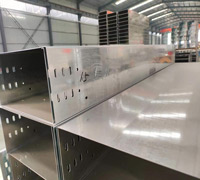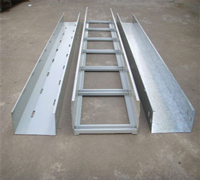The Cable Channel Forming Machine
The cable tray roll forming machine has significant advantages in improving production efficiency, reducing labor costs, and improving product quality, which is helpful for enterprises to enhance their competitiveness and achieve sustainable development.
We are a factory that develops and produces roll forming machines. Our main products are cable tray forming machines and related equipment, anti-seismic bracket roll forming equipment, light steel keel roll forming equipment, C/U steel roll forming equipment, etc. We also provide A good after-sales service. Please tell me your needs and our engineers will give you the best solution.
Equipment structure overview:
This production line can produce cable tray equipment structure overview:
This production line can produce cable trays of various specifications by changing the die to complete punching, roll forming, and computer adjustment. A set of rollers can complete cable tray products of various specifications. It can also produce coil materials and a variety of open flat materials with different widths and lengths. , and has a counter.
2.1 Material rack
1. Number of decoilers: one load-bearing machine, 8 tons
c.Technical parameters:
Roll inner diameter: φ508mm; inner diameter expansion and contraction range ф450-500;
Maximum outer diameter of material roll: φ1250mm;
2.2 Leveling machine
a. Form: Roller type active leveling machine
b. Functional and structural features: leveling steel belt. It consists of pinch rollers and leveling rollers. The pinch rollers can be adjusted individually. The upper leveling roller adopts an integral structure and has two adjustment points at the front and rear, which can form a certain tilt angle to improve the leveling quality. The upper pinch feeding and leveling rollers are raised and lowered using 8.8-grade high-quality ball screws. The frequency conversion high-speed motor is connected to the worm gear reducer to drive and transmit it to the lower pinch roller and leveling roller. The feed end of the leveling machine is equipped with a pair of guide flat rollers and two pairs of guide vertical rollers. The guide vertical rollers can move in center and at the same time. Handwheel adjustment with scale for easy centering.
Both the front and rear of the leveling machine are equipped with feed bridge devices. An electronic detection device is installed between the leveling machine and the feeder, which sends a feedback signal to the control system. The control system issues instructions to the variable frequency high-speed motor to change the speed to control the storage capacity of the material tape and achieve the purpose of uninterrupted leveling.
The leveling work roll adopts GCr15 high-frequency quenching, and the hardness can reach HRC45-55.
Motor power: 7.5KW
2.3 CNC feeder
a.Form: CNC feeding
b. Function and structure: convey strip steel to the press. The pressure roller ensures the feeding force. Compared with the servo clamp type, the feeding length setting is more flexible and the adaptability is wider.
This feeder is more suitable for feeding wide materials, and is suitable for feeding materials punched by large-sized non-hole bridges (trough type, without guide pins), which can effectively improve the feeding accuracy.
The motor, measuring components, and CNC system are high-precision electronic components.
2.4 Stamping mold
The mold is equipped with a sinking and floating pin guide and a material holding device. Punching is completed step by step, and the conversion of different widths can be completed. The connecting holes on both sides can be punched into through holes, and the bridge molds of the same width can share a mold base.
Mold material: Cr12
2.5 Cut off
a. Form: PLC controlled fixed-length cutting without waste.
b. Function and structure: Cutting the stamped strip to a fixed length. The cutting device is placed at the tail of the mold feeding direction, is powered separately from the punching device, and is controlled by PLC. The cutting length can be set by yourself, and the length is the step distance.
Cutting is performed after stamping, including cutting dies.
2.6 Conveying and feeding rack
a. Form: roller type adjustable
b. Function and structure: Guide the non-rolled steel plate into the roll forming machine smoothly. The guide device is mainly composed of horizontal rollers and guide vertical wheels. The guide wheels can be easily adjusted to adapt to various widths of sheets.
b.Technical parameters: Material width 180---1250mm
2.7 Molding machine
a. Form: Width-electrically adjustable cantilever forming machine, which can quickly change specifications (waist height and width);
b. Function and structure: The stamped and cut sheet is gradually rolled into the finished bridge through 25 passes of rollers. It consists of a speed-adjustable AC motor, a reducer, a high-precision rolling linear guide, a left and right transmission box, a transverse adjustment mechanism, and a roller set. A set of rollers can complete the bridge forming of various specifications, and the variety can be changed by adjusting the position of the left and right rollers. The bed and transmission box adopt welded structures and are stress-relieved; the gears adopt hard tooth surfaces; the main machine structure is manufactured using forging technology, with higher precision.
The roller adopts a combined structure, with small speed difference and forming resistance, and little wear on the surface of the steel plate; the roller process design uses imported software, computer design, and FEA analysis to ensure the shape accuracy of the product without scratching the sheet. The rollers are forged with GCr15 and CNC machined after overall quenching. The hardness can reach HRC58-62; it has the characteristics of high strength, high hardness, high precision, and service life. The last six forming rollers adopt GR12.
2.8 Discharge rack
a. Form: Manual cutting after the finished bridge is in place, no power roller.
b. Function and structure: It is assembled and welded by steel (square tube) and unpowered rollers, and plays the role of supporting materials for finished products.
2. 9 Electrical control system
The entire line is controlled by PLC, and the touch screen is used for human-machine interface to realize the interaction between humans and PLC. The operator issues instructions to the PLC and monitors the control process through it, allowing the operator to control the production line and modify the control parameters, and can monitor the equipment operating status, operating parameters and fault indications in real time. The length of the workpiece is digitally set and the length of the workpiece is adjustable. Real-time monitoring of equipment operating status and fault indications.
•The hardware configuration includes a power distribution cabinet console and counter; the machine is equipped with a remote control for easy adjustment.
•There are two modes of operation: manual/automatic. It has manual and automatic switching functions: in the manual state, it can operate as a single machine, which is convenient for maintenance; in the automatic state, it can carry out full-line production operation and start in sequence; the entire line is equipped with emergency stop buttons, which is easy to handle emergencies and ensures the safety of equipment and operators. Safety.
•There is a manual operation panel next to the machine to facilitate workers' operation;
•It has a good human-machine interface and is easy to operate. , punching and roll forming of various specifications are completed by changing the die, using computer adjustment, a set of rollers can complete various specifications of bridge products, and can produce coil materials and a variety of flat materials of different widths and lengths, and has a counter.
2.1 Material rack
1. Number of decoilers: one load-bearing machine, 8 tons
c.Technical parameters:
Roll inner diameter: φ508mm; inner diameter expansion and contraction range ф450-500;
Maximum outer diameter of material roll: φ1250mm;
2.2 Leveling machine
a. Form: Roller type active leveling machine
b. Functional and structural features: leveling steel belt. It consists of pinch rollers and leveling rollers. The pinch rollers can be adjusted individually. The upper leveling roller adopts an integral structure and has two adjustment points at the front and rear, which can form a certain tilt angle to improve the leveling quality. The upper pinch feeding and leveling rollers are raised and lowered using 8.8-grade high-quality ball screws. The frequency conversion high-speed motor is connected to the worm gear reducer to drive and transmit it to the lower pinch roller and leveling roller. The feed end of the leveling machine is equipped with a pair of guide flat rollers and two pairs of guide vertical rollers. The guide vertical rollers can move in center and at the same time. Handwheel adjustment with scale for easy centering.
Both the front and rear of the leveling machine are equipped with feed bridge devices. An electronic detection device is installed between the leveling machine and the feeder, which sends a feedback signal to the control system. The control system issues instructions to the variable frequency high-speed motor to change the speed to control the storage capacity of the material tape and achieve the purpose of uninterrupted leveling.
The leveling work roll adopts GCr15 high-frequency quenching, and the hardness can reach HRC45-55.
Motor power: 7.5KW
2.3 CNC feeder
a.Form: CNC feeding
b. Function and structure: convey strip steel to the press. The pressure roller ensures the feeding force. Compared with the servo clamp type, the feeding length setting is more flexible and the adaptability is wider.
This feeder is more suitable for feeding wide materials, and is suitable for feeding materials punched by large-sized non-hole bridges (trough type, without guide pins), which can effectively improve the feeding accuracy.
The motor, measuring components, and CNC system are high-precision electronic components.
2.4 Stamping mold
The mold is equipped with a sinking and floating pin guide and a material holding device. Punching is completed step by step, and the conversion of different widths can be completed. The connecting holes on both sides can be punched into through holes, and the bridge molds of the same width can share a mold base.
Mold material: Cr12
2.5 Cut off
a. Form: PLC controlled fixed-length cutting without waste.
b. Function and structure: Cutting the stamped strip to a fixed length. The cutting device is placed at the tail of the mold feeding direction, is powered separately from the punching device, and is controlled by PLC. The cutting length can be set by yourself, and the length is the step distance.
Cutting is performed after stamping, including cutting dies.
2.6 Conveying and feeding rack
a. Form: roller type adjustable
b. Function and structure: Guide the non-rolled steel plate into the roll forming machine smoothly. The guide device is mainly composed of horizontal rollers and guide vertical wheels. The guide wheels can be easily adjusted to adapt to various widths of sheets.
b.Technical parameters: Material width 180---1250mm
2.7 Molding machine
a. Form: Width-electrically adjustable cantilever forming machine, which can quickly change specifications (waist height and width);
b. Function and structure: The stamped and cut sheet is gradually rolled into the finished bridge through 25 passes of rollers. It consists of a speed-adjustable AC motor, a reducer, a high-precision rolling linear guide, a left and right transmission box, a transverse adjustment mechanism, and a roller set. A set of rollers can complete the bridge forming of various specifications, and the variety can be changed by adjusting the position of the left and right rollers. The bed and transmission box adopt welded structures and are stress-relieved; the gears adopt hard tooth surfaces; the main machine structure is manufactured using forging technology, with higher precision.
The roller adopts a combined structure, with small speed difference and forming resistance, and little wear on the surface of the steel plate; the roller process design uses imported software, computer design, and FEA analysis to ensure the shape accuracy of the product without scratching the sheet. The rollers are forged with GCr15 and CNC machined after overall quenching. The hardness can reach HRC58-62; it has the characteristics of high strength, high hardness, high precision, and service life. The last six forming rollers adopt GR12.












